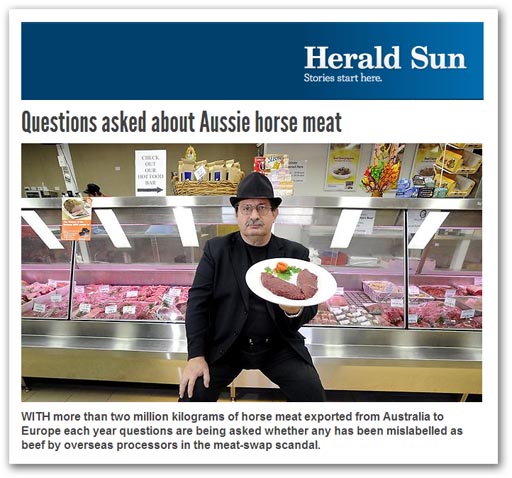This tied in with the news from Iceland that the production of horsemeat there had increased last year, from 878 to 1,500 tons - by 71 percent, with exports almost tripling between 2011 and 2012, from 311.7 to 875.6 tons - by 180.9 percent.
From here, the speculation arose that, if horsemeats exports to Europe were increasing across the board, with anecdotal evidence indicating that consumption was declining, this would give rise to a glut of horsemeat and explain why adulteration was taking place on such a heroic scale.
Sadly, though, the raw statistics do not bear this out. According to the very far from user-friendlyEurostat (see: Production and international trade of foodstuffs: Fresh meat and meat products (food_pd_prod2)), horsemeat volume traded in the EU27 is way down even over a period three years. In 2008, internal production plus imports from third countries, with negligible external exports, amounted to just short of 100,000 tons. In 2011, the equivalent figure was around 80,000 tons.
What we don't have, though, is any idea of what per capita consumption might be, nor any data which might give us consumption trends. The information simply isn't available. The last full dataset (food_pd_prod2) stops at 2008, while the user-functionality of other databases (such as DS_016893) is so obscure that it is frustratingly difficult to extract information from them (I spent four hours yesterday trying and failing to extract data on Australia).
Then, while we have some country-specific data on trade in the internal market, the information is all but useless. As we have seen recently, there are multiple cross-border transfers of product. The trading system is so porous that there is no way of being certain that imports into any one Member State are necessarily consumed there. Furthermore, once horsemeat is used in a processed food, even when sold quite legitimately, it loses its species identity and is recorded generically as a processed food.
This adds a new layer of complexity to this situation, as it had been generally assumed that a glut of cheap horsemeat was taking the place (in part) of the recently banned "desinewed meat" (DSM).
The absence of this product meant that thousands of tons of meat had to be sourced from elsewhere and at low cost, leading Dr Mark Woolfe, former head of food authenticity at the FSA, to suggest that "alarm bells" should have been set ringing. However, EU-wide DSM production probably exceeded the entire traded volume of horsemeat in Europe. The entire stock would not have compensated for the lost DSM.
This suggests that there is something more to these adulteration episodes than has so far been identified. It also suggests that, contrary to Dr Woolfe's assertions, straightforward market surveillance would not necessarily have provided the intelligence sufficient to raise suspicions that horsemeat adulteration was being practiced on an industrial scale. Apart from anything else, EU trade statistics are not sufficiently refined to be used as a surveillance tool.
On that basis, there seems considerably greater merit to suggestions that continuous random testing is a necessary part of the surveillance process. The indirect monitoring, which underpins the EU's control philosophy, would appear to be no substitute for hands-on product quality monitoring.
COMMENT: "HORSEMEAT" THREAD
